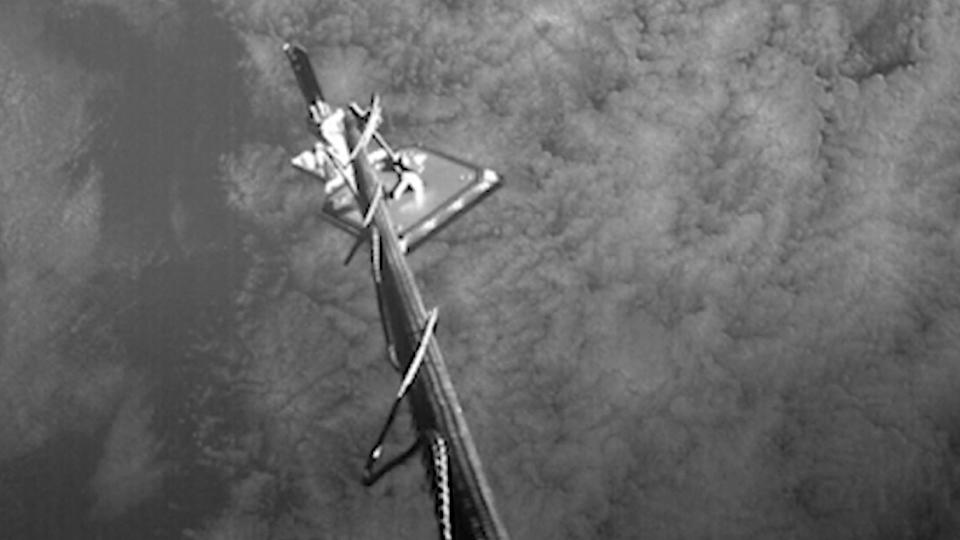SpaceX's 60 orbiting Starlink satellites lined up for an out of this world photo opp

It's been a couple days since SpaceX sent its first 60 Starlink satellites into orbit and the skywatching has begun.
A video captured by Dr. Marco Langbroek, who runs the StatTrack Cam Leiden Blog, shows the satellites all lined up as they sail through the sky. It looks like some kind of high-tech conga line, or an unintelligible string of Morse code.
Whatever it is you see when you look at this, we should all be able to agree that it's an unusual sight to behold in the night sky.
Langbroek points out in his accompanying blog post that the lineup you see here isn't a permanent arrangement.
"Over the coming days the 'train' of objects will be making 2-3 passes each night," he writes. "As they are actively manoeuvering with their ion thrusters, they will be more spread out with each pass, so the 'train' will probably quickly dissipate."
These 60 orbiting Starlink satellites are just the first set. SpaceX intends to get almost 12,000 of them into low Earth orbit, where they'll split into three separate groups that are each encased in an orbital shell.
The Starlink project is a massive telecommunications effort. Once the system is fully up and running — which likely won't be until 2027 at the earliest — this satellite constellation will have the ability to deliver high-speed internet to the entire planet.
The prospect of global high-speed internet may be exciting to you, but astronomers would also like you to remember that our night sky, and the ability to see beyond the bounds of Earth, is a treasure. There's no question that installing 12,000 satellites into low Earth orbit will disrupt that view in different places and at varying times.
Langbroek points to this thread from Cees Bassa, a professional astronomer.
These plots assume 53 degree inclined orbits at 550 km altitude, with 24 evenly spaced orbital planes, each having 66 #Starlink satellites. The total constellation would have 1584 objects. This is the initial @SpaceX plan for #Starlink.
— Cees Bassa (@cgbassa) May 26, 2019
But even in the spring, autumn and winter, around half a dozen #Starlink satellites will be visible at anytime upto 3 hours before sunrise and 3 hours after sunset. Depending on how bright they end up being, this will have a drastic impact on the character of the night sky.
— Cees Bassa (@cgbassa) May 26, 2019
It's unclear what this would mean for a 12000 satellites, as the details of their orbits are not known. A rough guess would be to multiply these numbers by a factor of 7 (12000/1600). So around 70 to 100 satellites visible during twilight at any time and any location!
— Cees Bassa (@cgbassa) May 26, 2019
Others, such as NASA's Doug Ellison — who, it should be noted, speaks only for himself here and not for NASA as a whole — take more of a position on what Starlink means for our ability to appreciate the night sky.
Ok. Starlink's kind of blown up over the past 48 hours. Let's get some things straight. Despite their creator insisting otherwise they WILL be naked eye visible, for at least an hour, more like two, after dark and before dawn. In higher latitudes in summer...all night....
— Doug Ellison (@doug_ellison) May 26, 2019
The above tweet is the start of a lengthy thread that we won't embed here in its entirety. It's an informative and factually supported consideration of what Starlink says about what the future looks like for Earthbound skywatchers.
It's worth your time to give the thread a full read if this is a subject you're interested in, but here's Ellison's final takeaway:
tldr - If you love the night sky, go and see it now before it's too late. Elon just opened Pandora's box, and it's going to shit on the night sky. And if you're a ground based astronomer.....your job just got a lot, lot harder. Because profit comes first. I am disgusted.
— Doug Ellison (@doug_ellison) May 26, 2019
WATCH: This space harpoon could be a solution to our growing space junk problem


